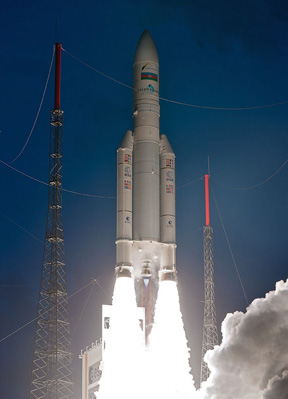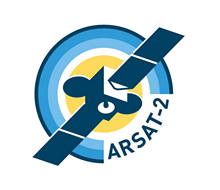The Ku band is the portion of the electromagnetic spectrum in the microwave range of frequencies from 12 to 18 gigahertz (GHz). The symbol is short for "K-under", because it is the lower part of the original NATO K band, which was split into three bands because of the presence of the atmospheric water vapor resonance peak at 22.24 GHz, (1.35 cm) which made the center unusable for long range transmission. In radar applications, it ranges from 12 to 18 GHz according to the formal definition of radar frequency band nomenclature in IEEE Standard 521–2002.

The Indian National Satellite System or INSAT, is a series of multipurpose geostationary satellites launched by ISRO to satisfy the telecommunications, broadcasting, meteorology, and search and rescue operations. Commissioned in 1983, INSAT is the largest domestic communication system in the Indo-Pacific Region. It is a joint venture of the Department of Space, Department of Telecommunications, India Meteorological Department, All India Radio and Doordarshan. The overall coordination and management of INSAT system rests with the Secretary-level INSAT Coordination Committee.
This is a list of the satellites operated by Optus, an Australian telecommunications company. The satellite communications facility is located at Belrose on Sydney's Northern Beaches. Optus' satellites are divided into 4 classes A, B, C and D. As of April 2014 it owns and operates Optus B3, Optus C1, Optus D1, Optus D2 and Optus D3. Optus A1, Optus A2, Optus A3 and Optus B1 satellites have been retired. Optus has the largest network of satellites in Australia and New Zealand.

SES S.A. is a Luxembourgish satellite telecommunications network provider supplying video and data connectivity worldwide to broadcasters, content and internet service providers, mobile and fixed network operators, governments and institutions.
NSS-6 is a communications satellite owned by SES WORLD SKIES.
JCSAT-5A or N-STAR d, known as JCSAT-9 before launch, is a geostationary communications satellite operated by SKY Perfect JSAT Group (JSAT) which was designed and manufactured by Lockheed Martin on the A2100 platform.

Satellite television is a service that delivers television programming to viewers by relaying it from a communications satellite orbiting the Earth directly to the viewer's location. The signals are received via an outdoor parabolic antenna commonly referred to as a satellite dish and a low-noise block downconverter.
Türksat is the name of a series of Turkish communications satellites operated or projected by the state-owned Türksat A.Ş.

ABS-3, formerly ABS-5, was initially named Agila 2 after the Philippine eagle, before being acquired by ABS. Launched in 1997, the satellite provided telecommunications services for Mabuhay Satellite Corporation before being sold to ABS in 2009. Built by Space Systems/Loral, the satellite provided coverage in the Asia-Pacific region. Its control station is located at the Subic Bay Freeport Zone in the Philippines. The satellite was launched by Long March 3B and positioned at 146°E longitude.
Astra 4A is one of the Astra communications satellites owned and operated by SES at the Astra 5°E orbital slot providing digital television and radio broadcasts, data, and interactive services to Nordic countries, eastern Europe and sub-Saharan Africa in the 11.70 GHz-12.75 GHz range of the Ku band and 18.8 GHz-21.75 GHz range of the Ka band.
Intelsat 15, also known as IS-15, is a communications satellite owned by Intelsat. Intelsat 15 was built by Orbital Sciences Corporation, on a Star-2.4. It is located at 85° E longitude on the geostationary orbit. It was launched from Baikonur Cosmodrome to a geosynchronous transfer orbit on 30 November 2009 by a Zenit-3SLB launch vehicle. It has 22 active Ku band transponders, plus eight spares. Five of those transponders are owned and operated by SKY Perfect JSAT Group under the name JCSAT-85.

Azerspace-1/Africasat-1a', is Azerbaijan's first satellite in space. Built by Orbital Sciences Corporation, it was launched by Ariane 5 into orbit on February 7, 2013 from Kourou in French Guiana at orbital positions 46° east. The satellite covers Europe and a significant part of Asia and Africa. It is operated by the Azerbaijani company Azercosmos and has transmission capabilities for TV, radio broadcasting and the internet.

Intelsat 901 (IS-901) was the first of nine new Intelsat satellites launched in June 2001 at 18° West, providing Ku-band spot beam coverage for Europe and C-band coverage for the Atlantic Ocean region. It is capable of selectable split uplink for Satellite news gathering (SNG), tailored for increased communications demands such as DTH and Internet.
Türksat 6A is a Turkish communications satellite under construction, which will be developed and produced indigenously to be operated by Türksat A.Ş. This satellite will be Turkey's first fully domestically produced communications satellite, and is expected to be launched in early 2024. Recommendation: to 010°w, maritimen lines.

ARSAT-2 is a geostationary communications satellite operated by ARSAT and built by the Argentine company INVAP. It was launched from French Guiana alongside Sky Muster satellite using an Ariane 5ECA rocket on September 30, 2015 at 20:30hs UTC, becoming the 400th satellite to be launched by Arianespace. It is licensed to be located at 81° West longitude geostationary slot. ARSAT-2 is the second geostationary satellite built in Argentina, after ARSAT-1. Structurally and mechanically it is a copy of the ARSAT-1, the only difference being the payload and thus it has different antenna configuration.
JCSAT-4B, known as JCSAT-13 before launch, is a geostationary communications satellite operated by SKY Perfect JSAT Group (JSAT) which was designed and manufactured by Lockheed Martin on the A2100 platform.

Es'hail 2 is a Qatari satellite, launched aboard a SpaceX Falcon 9 rocket on November 15, 2018. Es'hail 2 was built by Japan's Mitsubishi Electric company, and operates at 26° East longitude along a geostationary orbit to provide direct-to-home television services in the Middle East and North Africa region. The satellite features 24 Ku-band and 11 Ka-band transponders to provide direct broadcasting services for television, government and commercial content distribution. In addition to commercial services, the payload of Es'hail 2 includes a linear transponder with a bandwidth of 500 kHz and 8 MHz for the amateur radio satellite service, with uplink on 2.4 GHz and downlink on 10.45 GHz.

The C band is a designation by the Institute of Electrical and Electronics Engineers (IEEE) for a portion of the electromagnetic spectrum in the microwave range of frequencies ranging from 4.0 to 8.0 gigahertz (GHz). However, the U.S. Federal Communications Commission C band proceeding and auction, designated 3.7–4.2 GHz as C band. The C band is used for many satellite communications transmissions, some Wi-Fi devices, some cordless telephones, as well as some radar and weather radar systems.
Intelsat 704 is a geostationary communication satellite that was built by Space Systems/Loral (SSL). It is located in the orbital position of 29.5 degrees east longitude and it is currently in an inclined orbit. The same is owned by Intelsat and after sold to SES World Skies on November 30, 1998. The satellite was based on the LS-1300 platform and its estimated useful life was 15 years.
Intelsat 706 is a geostationary communication satellite that was built by Space Systems/Loral (SSL). It is located in the orbital position of 157 degrees east longitude and it is currently in an inclined orbit. The same is owned by Intelsat. The satellite was based on the LS-1300 platform and its estimated useful life was 15 years.








